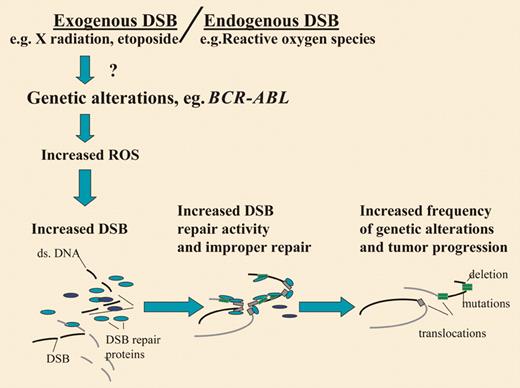Comment on Nowicki et al, page 3746
There is mounting evidence that an increase in mutation frequency and, hence, the accumulation of genetic alterations accompany progression of human solid tumors and leukemias. Here, Nowicki and colleagues present evidence that cells harboring the oncogenic BCR-ABL show an increase in ROS, which leads to an increase in DSBs and inaccurate repair, introducing further genetic changes. Thus, acquisition of an oncogenic translocation can initiate a cycle of genomic instability that has the potential to create other mutations.
Human leukemias are characterized by genomic instability, of which chromosomal rearrangements constitute one type.1 A well-established way in which DNA rearrangements or mutations can be generated is through the improper induction and repair of double-strand breaks (DSBs).2 These can be induced in cellular DNA, for example, through extrinsic insults such as exposure to X-radiation or intrinsically through increased production of reactive oxygen species (ROS).2 Recent studies have shown that several myeloid leukemias, including Philadelphia chromosome 1 (Ph1)–positive chronic myeloid leukemia (CML), generate endogenous DSBs with concomitantly increased frequencies of improper repair of this DNA damage via nonhomologous end-joining (NHEJ),FIG1 one of the main pathways for the repair of DSBs in mammalian cells.3 These data, therefore, pointed to a possible mechanism by which increased DNA damage and consequent errorprone repair could lead to the acquisition of further genetic changes that may drive progression of human myeloid leukemia.4
Model for the acquisition of genomic instability by oncogenic genetic alterations such as BCR-ABL. Here BCR-ABL leads to increased reactive oxygen species (ROS), which generate increased double-strand breaks (DSBs) and incorrect repair, thus introducing further genetic changes into cells, leading to tumor progression.
Model for the acquisition of genomic instability by oncogenic genetic alterations such as BCR-ABL. Here BCR-ABL leads to increased reactive oxygen species (ROS), which generate increased double-strand breaks (DSBs) and incorrect repair, thus introducing further genetic changes into cells, leading to tumor progression.
In this issue of Blood, Nowicki and colleagues have taken the work on genomic instability in Ph1-positive CML a step further, elucidating a mechanism for the generation of endogenous DSBs and the induction of genomic instability. These authors elegantly show that the oncogenic BCR-ABL fusion gene, resulting from the reciprocal translocation of chromosome 9q34 with 22q11 [(t9; 22)(q34;q11)], present in cells of the vast majority of chronic myeloid leukemia patients, produces increased ROS, which in turn gives rise to increased DSBs. Strikingly, the increased ROS and DSBs (quantitated by assays such as phosphorylated histone vari γH2AX foci formation) are dramatically reduced by agents that inhibit DSB repair, block the BCR-ABL tyrosine kinase activity (STI571), or inhibit generation of ROS (the antioxidant, pyrrolidine dithiocarbamate [PDTC]). The authors found that subsequent repair of endogenous DSBs by both NHEJ and another important pathway for the repair of DSBs, homologous recombination repair (HRR), was also enhanced. However, a significant percentage of these DSBs are repaired incorrectly, leading to an increase in the frequency of DNA deletions and mutations.
CML cells accumulate genetic/chromosomal abnormalities during the course of the disease. While the origin of these changes is unknown, these authors speculate that genetic instability leading to malignant progression of Ph1-positive leukemias is associated with non-faithful repair of ROS-induced DSBs. These results are in keeping with the idea that the accumulation of genetic/chromosomal changes in cancer require a mutator phenotype.5 Thus, ROS induction, followed by DSB repair with increased infidelity may represent a new type of mutator phenotype (Figure 1). The question of whether acquisition of the Ph1 chromosomal translocation itself results from episodes of ROS-mediated genotoxic stress involving BCR and ABL genes, followed by nonfaithful repair, is still to be determined. More profoundly, increased ROS production and consequent improper repair of DSBs could represent one of the universal mechanisms for creating genomic instability in human tumors. Thus, it will be important to determine whether other oncogenic rearrangements, such as rearrangements of the MLL gene or mutations of genes such as NRAS, also induce an increase in ROS with a subsequent increase in mutation frequency.


This feature is available to Subscribers Only
Sign In or Create an Account Close Modal